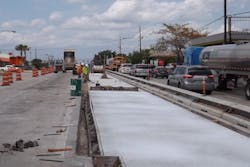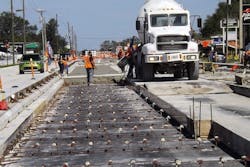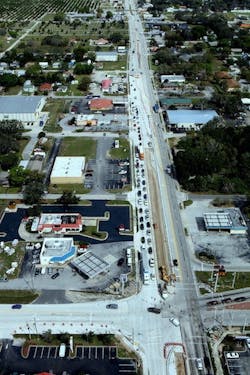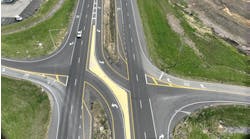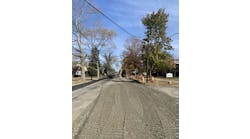Concrete pavement replacement serves motorists well at key Florida intersection
By: Tim Bruns
The city of Avon Park in Florida—so named for Stratford-upon-Avon in the United Kingdom, which is otherwise known as the birthplace of William Shakespeare—is not only the oldest city in Highlands County, but is also home to one of the county’s busiest intersections.
That intersection would be none other than where S.R. 64 meets U.S. 27. The Florida DOT (FDOT) officially embarked on a mission to make upgrades to the intersection when construction began on the improvements project in June 2018. This particular intersection sees a significant amount of truck traffic, as U.S. 27 allows for major goods to be shipped all the way from Miami to this more central Florida location. In addition, the busy intersection has historically been the site of myriad traffic crashes, which have resulted in injury or death to pedestrians, drivers, and passengers alike.
“We’ve got a lot of truck traffic at that intersection, so we’re trying to reduce the off-tracking of the intersection, widening the radius along that intersection, as well as eliminating the rutting,” Randall James, FDOT construction engineer, told Roads & Bridges. Ultimately, in addition to addressing rutting issues, a concrete pavement replacement was chosen for its durability to service a corridor with heavy truck traffic. “Prior to construction, this was an intersection done in asphalt. So we were trying to address that rutting issue we were having in the intersection. And we did some improvements to the traffic and pedestrian signals.”
The project limits of the roughly $8 million intersection improvements at U.S. 27 and S.R. 64 cover just under half a mile, stretching from West Townsend Street to Batts Street on U.S. 27 and from Self Avenue to U.S. 27 on S.R. 64. U.S. 27 is a major thoroughfare throughout the state of Florida, with an average annual daily traffic (AADT) count of approximately 32,000 vehicles in this area; S.R. 64 serves residents of Avon Park by providing a connection to the west coast of the state, including nearby communities in Hardee County. S.R. 64 sees approximately 10,000 vehicles in AADT.
The team at FDOT, along with the help of contracting firm Concrete Services Inc., had their work cut out for them as the improvements project included 22 major phases of work along a limited right-of-way and required an aggressive work schedule and extensive coordination with local businesses affected by construction.
Major improvements
The key objectives for the U.S. 27/S.R. 64 intersection improvements included replacing the existing roadway with concrete pavement from U.S. 27 southbound from West Pleasant Street to Paulk Street; U.S. 27 northbound from Dyal Street to West Hill Street; and S.R. 64 from Self Avenue to U.S. 27. Work also included the construction of an eastbound right-turn lane on S.R. 64 to U.S. 27 as well as an upgrade to the southbound right-turn lane along U.S. 27 to S.R. 64.
Other improvements to the intersection consisted of the replacement of traffic signals at the intersection; the installation of new pavement markings and signage; the installation of concrete curb, sidewalks, and a traffic separator; and the addition of eight new streetlights and improved drainage. The major components of this project were a highly involved process as the project was divided up into 22 main phases in FDOT’s traffic control plan.
“We had to maintain two lanes of traffic on S.R. 64 and four lanes on U.S. 27, plus the turn lanes,” James said. “So on S.R. 64, traffic was shifted onto existing and temporary pavement to build the south side, including the right-turn lane that we put in. And then the traffic was switched to the new concrete pavement and temporary pavement to build the north side on S.R. 64.”
On U.S. 27—which is a six-lane highway—construction started on the southbound side and worked across the road. The old road was removed, and the new concrete pavement was constructed one or two lanes at a time, depending on the contractor’s productivity. The team replaced roughly 1,600 ft of roadway on each approach to the intersection with 11.5 in. of portland cement concrete pavement. The material was class 1 concrete with 3,000 psi minimum strength at a 20-day break time.
Replacing the existing roadway with concrete pavement required some patience for everyone involved, as concrete takes longer to cure than asphalt—resulting in a longer lane closure time to the traveling public. But FDOT made it a priority to communicate with motorists and affected businesses through notices to the local media and signage notifying travelers of upcoming closures. “There were quite a few businesses that were being affected by the construction,” James said. “So we had to obviously get the word out there to businesses and also maintain access to those businesses at all times throughout the life of the project.”
On the contractor’s side, the team faced the difficult task of working on the improvements while implementing the strict traffic control plan in a limited right-of-way. “They had to maintain minimum lane widths for traffic, and again with a lot of truck traffic, you couldn’t make the lanes too narrow because you have to take into account the truck traffic,” James explained. The team also had to account for the higher levels of pedestrian traffic due to the number of local businesses within the project limits.
Ahead of the game
The original target date for project completion was February 2020, but the team at FDOT ended up working ahead of schedule in order to ease construction impacts to the traveling public and local businesses. In order to meet the goal of finishing up by October 2019, some minor modifications to the maintenance of traffic plan were made to expedite construction. The contractor combined phases in some instances to accelerate the schedule, and also worked extra hours to ensure the target completion was met or exceeded.
“They worked seven days a week,” Stacy Hill, FDOT project manager, told Roads & Bridges. “A lot of it being 24-hour work pulling shifts to be able to implement that concrete.”
Another solution the contractor implemented into the project in order to expedite the process was to incorporate innovative material substitutions. “In order for us to move more quickly, the contractor elected to use class 4 concrete with a strength of 5,500 psi, with the same 28-day compressive strength break time,” James said. “So all that concrete was used to help accelerate the project and get it done a little quicker.”
Some of the steps taken to manage traffic during construction included relying on temporary pavements, which was used to provide extra road width to allow traffic to move through the work zones and maintain enough space for the work area. The team also implemented the use of low-profile concrete barriers to protect traffic from the work zone. Most of the work in the intersection was completed in very small sections working day and night over the weekends when traffic volumes were the lowest. The contractor also used flagging personnel and off-duty law enforcement officers extensively during the work in the intersection to provide direction and safety to the traveling public.
Overall, the team faced minimal impacts to the work schedule, with one exception being at the end of this summer when the threat of Hurricane Dorian loomed over the southeastern U.S. and the Caribbean. Along with other states in the region, the state of Florida was under a state of emergency that began on Aug. 28, 2019, which shut the project site down for a week. The storm, however, did not significantly impact the area.
Since the project finished up in October, FDOT has largely heard nothing but praise for the new pavement and the efficiency of the accelerated project schedule. “Definitely everyone is excited that the intersection’s open,” James said. “They’re happy with our choice of concrete because there were, prior to construction, those ruts there that we would get occasional calls about. So with the selection of concrete, we heard good feedback about that.”
Shakespeare once noted—in his comedy As You Like It—that “travelers must be content.” With the completion of these intersection improvements, it appears as if the travelers of Avon Park—a namesake for The Bard’s hometown—now can be.
About The Author: Bruns is associate editor of Roads & Bridges.
